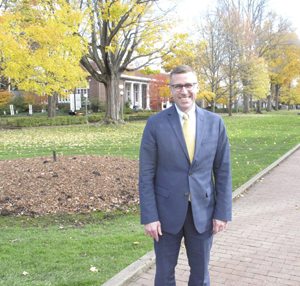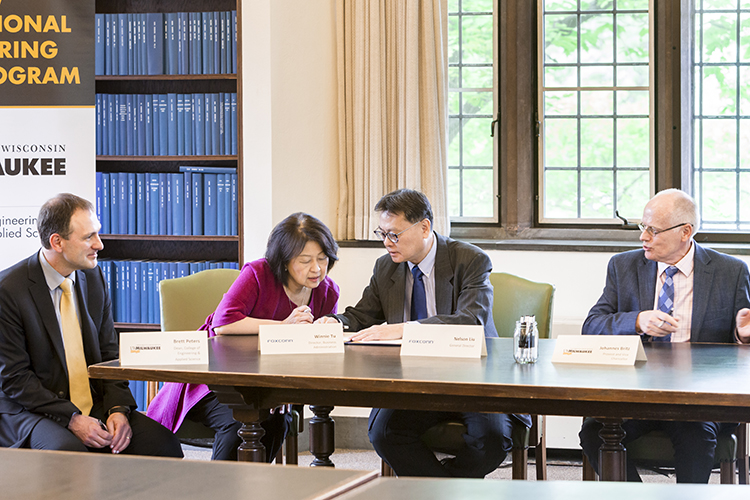Report on the “FogAg” Precision Agriculture Initiative
Project Funding and Leadership
A multi-institutional research project, “FogAg,” has been awarded an $827,533 grant from the United States Department of Agriculture’s National Institute of Food and Agriculture. The project is led by Dr. Arslan Munir, an associate professor at Florida Atlantic University’s (FAU) College of Engineering and Computer Science. The initiative represents a collaborative effort between FAU, Kansas State University, and Purdue University.
Alignment with Sustainable Development Goals (SDGs)
The FogAg project is designed to address critical global challenges by developing an advanced edge/fog computing-based framework for precision agriculture. Its objectives are directly aligned with several United Nations Sustainable Development Goals (SDGs), aiming to create a more sustainable and efficient food production system.
SDG 2: Zero Hunger & Sustainable Agriculture
The project directly targets SDG 2 by seeking to enhance agricultural productivity and ensure sustainable food production systems.
- Increased Crop Yield: By providing real-time, multi-layer sensing and analysis of water and nitrogen levels, the framework empowers farmers to make precise, data-driven decisions that increase crop yield and quality.
- Sustainable Practices: The technology promotes resilient agricultural practices that combat land degradation and improve soil quality, contributing to the long-term goal of ending hunger.
SDG 12: Responsible Consumption and Production
FogAg promotes sustainable production patterns by optimizing the use of critical natural resources.
- Resource Efficiency: The core objective is to improve the management of water and nitrogen, two vital but often mismanaged crop inputs.
- Waste Reduction: By enabling site-specific, variable-rate prescriptions for fertilizer and irrigation, the system minimizes input waste and reduces the environmental impact of agricultural operations.
Technological Innovation for Sustainable Development
Contribution to SDG 9: Industry, Innovation, and Infrastructure
The project leverages cutting-edge technology to build resilient infrastructure and foster innovation within the agricultural sector.
- Advanced Computing Architecture: FogAg utilizes a novel, three-tiered cyber-physical architecture (IoT devices, fog computing nodes, cloud servers) for distributed, near real-time data processing.
- Multi-Modal Sensing Platform: A suite of innovative sensors will be deployed to capture a comprehensive picture of crop and soil health, including an LED-based multispectral imaging system, a near-infrared point measurement sensor, and a dielectric soil sensor.
- Machine Learning and Predictive Modeling: The framework incorporates a highly efficient convolutional neural network accelerator and tree-based predictive models to translate complex data into actionable insights for farmers.
Projected Environmental and Societal Impacts
Contribution to Environmental and Climate Goals (SDG 6, 13, 15)
The FogAg framework is poised to deliver significant environmental benefits by mitigating the negative impacts of conventional agriculture.
- SDG 6 (Clean Water and Sanitation): Optimized water and nitrogen management will reduce agricultural runoff, a major source of water pollution, thereby protecting and restoring water-related ecosystems.
- SDG 13 (Climate Action): By reducing fertilizer waste, the project helps lower agriculture’s nitrogen footprint, which includes emissions of nitrous oxide, a potent greenhouse gas.
- SDG 15 (Life on Land): Minimizing chemical runoff helps protect terrestrial ecosystems and biodiversity from pollution.
Contribution to Education and Partnerships (SDG 4, 17)
The initiative extends beyond technical research to include capacity building and collaboration, which are essential for achieving the SDGs.
- SDG 4 (Quality Education): Project findings will be integrated into undergraduate and graduate curricula, training the next generation of scientists and engineers in sustainable agriculture technologies.
- SDG 17 (Partnerships for the Goals): The project is founded on a multi-institutional partnership between three leading universities, exemplifying the collaborative approach needed to address complex global challenges.
SDGs Addressed in the Article
SDG 2: Zero Hunger
- The article directly addresses the challenge of “feeding a growing population” and aims to enhance “sustainable food production.” The FogAg project’s goal to “increase crop yield and quality” is central to ensuring food security.
SDG 6: Clean Water and Sanitation
- The project focuses on managing “water and nitrogen” to “protect natural resources.” It aims to reduce environmental harm from “runoff and waste,” which directly relates to improving water quality and promoting efficient water use in agriculture.
SDG 9: Industry, Innovation, and Infrastructure
- The article describes a “groundbreaking, multi-institutional research project” centered on technological innovation. The development of the “FogAg” framework, which integrates “edge/fog computing, cyber-physical systems, and multi-modal sensing,” represents a significant advancement in agricultural technology and infrastructure.
SDG 4: Quality Education
- The project has a strong educational component, as it plans to “incorporate its findings into both undergraduate and graduate curricula.” This initiative will train the “next generation of engineers and scientists in the practical application of smart agriculture technologies,” contributing to quality education for sustainable development.
SDG 12: Responsible Consumption and Production
- The core of the FogAg project is to improve resource efficiency. By enabling “site-specific, variable-rate prescriptions for fertilizer and irrigation,” it aims to maximize “productivity while minimizing input waste” and reduce “agriculture’s nitrogen footprint,” promoting sustainable management of natural resources.
SDG 17: Partnerships for the Goals
- The article highlights that the project is a “multi-institutional research project with FAU, Kansas State University and Purdue University.” This collaboration between academic institutions to advance science and technology for sustainable development is a clear example of a partnership for the goals.
Specific SDG Targets Identified
SDG 2: Zero Hunger
- Target 2.4: “By 2030, ensure sustainable food production systems and implement resilient agricultural practices that increase productivity and production…” The article supports this by describing the FogAg framework’s aim to “increase crop yield and quality” and create a “next-generation agricultural system” that promotes “sustainable food production.”
- Target 2.a: “Increase investment… in agricultural research and extension services, technology development…” The $827,533 grant from the USDA for this “groundbreaking, multi-institutional research project” is a direct investment in agricultural research and technology development.
SDG 6: Clean Water and Sanitation
- Target 6.3: “By 2030, improve water quality by reducing pollution…” The project’s goal to reduce “runoff and waste” and lower “agriculture’s nitrogen footprint and associated environmental pollution” directly contributes to this target.
- Target 6.4: “By 2030, substantially increase water-use efficiency across all sectors…” The framework’s ability to provide “real-time, multi-layer sensing and analysis of how water and nitrogen levels” affect crops is designed to enhance “resource-use efficiency” in agriculture.
SDG 9: Industry, Innovation, and Infrastructure
- Target 9.5: “Enhance scientific research, upgrade the technological capabilities of industrial sectors… encouraging innovation…” The entire project, focused on developing an “advanced edge/fog computing-based framework” and exploring “new innovations across multiple domains,” directly aligns with enhancing scientific research and upgrading technology in the agricultural sector.
SDG 4: Quality Education
- Target 4.7: “By 2030, ensure that all learners acquire the knowledge and skills needed to promote sustainable development…” The plan to “incorporate its findings into both undergraduate and graduate curricula” ensures that students gain knowledge and skills in “smart agriculture technologies” and “sustainable food production.”
SDG 12: Responsible Consumption and Production
- Target 12.2: “By 2030, achieve the sustainable management and efficient use of natural resources.” The project’s objective to create “variable-rate prescriptions for fertilizer and irrigation” to maximize productivity while “minimizing input waste” is a direct application of this target.
SDG 17: Partnerships for the Goals
- Target 17.6: “Enhance… international cooperation on and access to science, technology and innovation…” The collaboration between Florida Atlantic University, Kansas State University, and Purdue University on a high-tech agricultural project exemplifies this target by fostering cooperation to advance science and technology.
Indicators for Measuring Progress
SDG 2: Zero Hunger
- Implied Indicators: Increased “crop yield and quality,” and the rate of adoption of “site-specific, variable-rate prescriptions for fertilizer and irrigation” by farmers. The amount of investment in research, indicated by the “$827,533 grant,” is also a measurable input.
SDG 6: Clean Water and Sanitation
- Implied Indicators: Measured reduction in “runoff” of nitrogen and other inputs from farms using the technology. An increase in “water-use efficiency,” measured as crop output per unit of water consumed. A quantifiable decrease in “agriculture’s nitrogen footprint.”
SDG 9: Industry, Innovation, and Infrastructure
- Mentioned/Implied Indicators: The successful development and deployment of the “FogAg framework,” including its components like the “LED-based multispectral imaging system” and “convolutional neural network accelerator.” The number of farms or agricultural systems adopting the technology would also be an indicator.
SDG 4: Quality Education
- Implied Indicators: The number of “undergraduate and graduate curricula” updated to include the project’s findings. The number of “engineers and scientists” trained in these new smart agriculture technologies.
SDG 12: Responsible Consumption and Production
- Implied Indicators: A measured reduction in “input waste” (e.g., tons of fertilizer saved, cubic meters of water saved). An overall increase in “resource-use efficiency” on farms implementing the FogAg system.
SDG 17: Partnerships for the Goals
- Mentioned Indicator: The existence of the “multi-institutional research project” itself, involving three distinct universities (FAU, Kansas State, Purdue) working collaboratively on a shared technological and sustainability goal.
SDGs, Targets, and Indicators Analysis
| SDGs | Targets | Indicators (Mentioned or Implied in the Article) |
|---|---|---|
| SDG 2: Zero Hunger | 2.4: Ensure sustainable food production systems and resilient agricultural practices. 2.a: Increase investment in agricultural research and technology. |
– Increase in “crop yield and quality.” – Adoption rate of “site-specific” farming practices. – Investment amount: “$827,533 grant.” |
| SDG 6: Clean Water and Sanitation | 6.3: Improve water quality by reducing pollution. 6.4: Substantially increase water-use efficiency. |
– Reduction in agricultural “runoff and waste.” – Decrease in “agriculture’s nitrogen footprint.” – Increase in “resource-use efficiency” (water and nitrogen). |
| SDG 9: Industry, Innovation, and Infrastructure | 9.5: Enhance scientific research and upgrade technological capabilities. | – Development and deployment of the “FogAg” framework. – Creation of new sensing technologies (e.g., “LED-based multispectral imaging system”). |
| SDG 4: Quality Education | 4.7: Ensure learners acquire knowledge and skills for sustainable development. | – Number of “undergraduate and graduate curricula” updated. – Number of “engineers and scientists” trained in smart agriculture. |
| SDG 12: Responsible Consumption and Production | 12.2: Achieve the sustainable management and efficient use of natural resources. | – Reduction in “input waste” (fertilizer and water). – Maximized productivity per unit of resource input. |
| SDG 17: Partnerships for the Goals | 17.6: Enhance cooperation on and access to science, technology, and innovation. | – Existence of the “multi-institutional research project” (FAU, Kansas State University, Purdue University). |
Source: theinvadingsea.com







